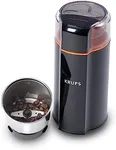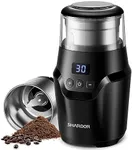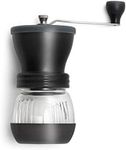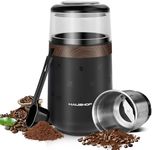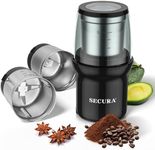Buying Guide for the Best Quiet Coffee Grinder
Choosing the right coffee grinder can significantly enhance your coffee experience. A quiet coffee grinder is particularly important if you want to enjoy your coffee-making ritual without disturbing others in your household or if you prefer a peaceful environment. When selecting a quiet coffee grinder, there are several key specifications to consider. Understanding these specs will help you make an informed decision and find the best fit for your needs.Noise LevelNoise level is a measure of how loud the coffee grinder is during operation. This spec is important because a quieter grinder will be less disruptive, especially in the morning or in shared living spaces. Noise levels are usually measured in decibels (dB). A lower dB value indicates a quieter grinder. For a quiet coffee grinder, look for models that operate at around 60-70 dB or lower. If you are sensitive to noise or live with others, choosing a grinder with a lower noise level will be beneficial.
Grind ConsistencyGrind consistency refers to how uniform the coffee grounds are after grinding. This is important because consistent grounds ensure even extraction and better-tasting coffee. Grinders can be divided into blade grinders and burr grinders. Blade grinders tend to be less consistent, while burr grinders offer more uniformity. If you are particular about the quality of your coffee, opt for a burr grinder, which can provide a more consistent grind.
Grind SettingsGrind settings determine the range of coarseness or fineness you can achieve with your grinder. This is important because different brewing methods require different grind sizes. For example, espresso requires a fine grind, while French press needs a coarse grind. Grinders with multiple settings offer more versatility. If you enjoy experimenting with different brewing methods, choose a grinder with a wide range of grind settings. If you stick to one method, ensure the grinder can achieve the specific grind size you need.
CapacityCapacity refers to the amount of coffee beans the grinder can hold at one time. This is important if you need to grind large quantities of coffee at once. Grinders come with different capacities, ranging from small (suitable for single servings) to large (suitable for multiple cups). If you usually make coffee for just yourself, a smaller capacity grinder will suffice. If you often brew for a group, consider a grinder with a larger capacity.
Build QualityBuild quality refers to the materials and construction of the grinder. This is important for durability and longevity. Grinders made with high-quality materials like stainless steel or ceramic tend to last longer and perform better. If you want a grinder that will withstand regular use and last for years, look for one with a solid build quality. Consider the overall design and feel of the grinder to ensure it meets your expectations for durability.
Ease of CleaningEase of cleaning refers to how simple it is to maintain the grinder. This is important for hygiene and the longevity of the grinder. Some grinders have removable parts that make cleaning easier, while others may require more effort. If you prefer low-maintenance appliances, choose a grinder that is easy to disassemble and clean. Regular cleaning will ensure your grinder continues to perform well and your coffee tastes fresh.
